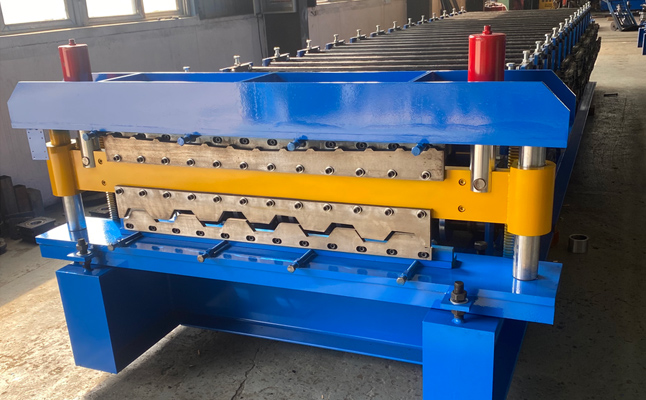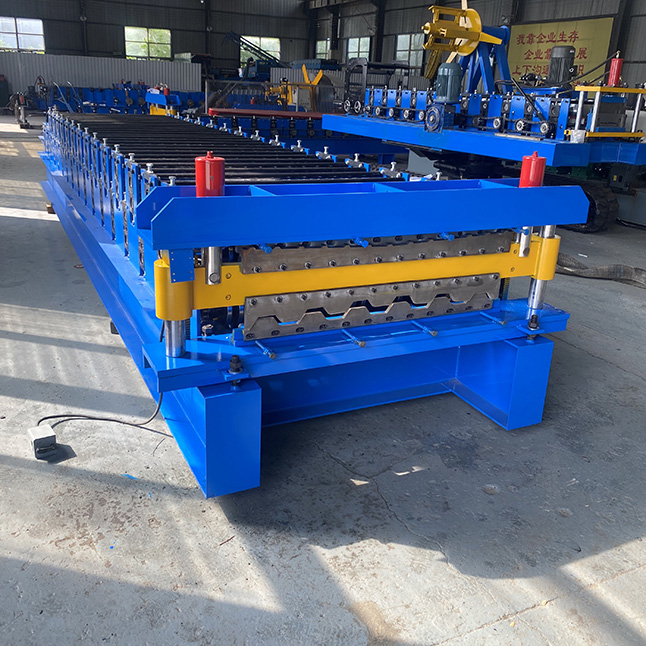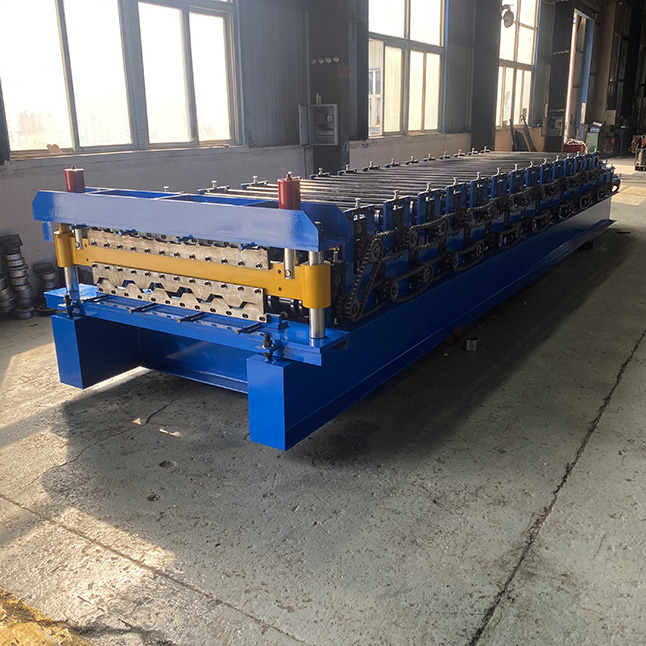
Price:
Detailed Introduction
The double-layer tile pressing machine is a device used to press metal sheets into tiles of different shapes.It can produce two different specifications or types of tiles on the same machine,effectively improving production efficiency and site utilization.One machine has two uses,small footprint,convenient transportation,and cost savings.The following is an introduction from the aspects of its structure,working principle,characteristics,technical parameters,maintenance,etc.

Structural composition
Unwinding system:It consists of an unwinder and a loading rack.The unwinder is used to place metal coils and adjust the tension to make the coils unfold smoothly to ensure smooth feeding.The loading rack assists the loading process of the coils to ensure that they enter the subsequent processing links accurately.
Forming system:This is the core part of the double-layer tile pressing machine,which includes two sets of independent tile pressing molds and roller devices.Each set of molds corresponds to a tile type.Through the gradual rolling of the rollers,the metal sheet is pressed and formed according to the shape of the mold.For example,one set of molds can produce common trapezoidal tiles,and the other set can produce corrugated tiles.The rollers are usually made of high-quality alloy steel,and after special heat treatment,they have high hardness and wear resistance to ensure long-term stable production.
Transmission system:It is composed of motor,reducer,chain or gear,etc.The motor provides power,the reducer adjusts the speed,and transmits power to the rollers of the forming system through chains or gears to ensure that each roller rotates synchronously and stably to achieve continuous forming of the sheet.
Shearing system:It is composed of a cutting machine and a control system.After the sheet is pressed into the required length of tile material,the cutting machine cuts it according to the set length.The cutting methods include mechanical shearing and hydraulic shearing.The hydraulic shearing method has the advantages of large shearing force and smooth cut.The control system accurately controls the action of the cutting machine to ensure the accuracy of the cutting length.
Control system:It is controlled by PLC(programmable logic controller)or industrial computer.The operator can easily set various parameters such as tile type selection,production speed,cutting length,etc.through the operation panel.The control system also has a fault diagnosis function.When the equipment is abnormal,it can quickly display the fault information,which is convenient for maintenance personnel to check and repair in time.
Working principle
The metal coil is unrolled from the unwinder and enters the forming system through the loading rack.In the forming system,the sheet first enters a selected set of tile pressing molds,and gradually forms the tile shape set by the set of molds through the gradual bending and pressing of a series of rollers.As the sheet continues to move forward,when it reaches the set length,the shearing system's cutting machine starts to cut the formed tile.After completing the production of one type of tile,the control system can switch to another set of molds,repeat the above process,and produce another type of tile.The whole process has a high degree of automation and can continuously produce tiles of different specifications.
Features
Efficient production:Two types of tiles can be produced alternately on one device without replacing the entire device,which greatly saves production time and cost and improves production efficiency.For example,in a construction project,when trapezoidal tiles and corrugated tiles are required at the same time,the double-layer tile pressing machine can quickly switch production to meet construction needs.
Space saving:Compared with two separate tile pressing machines,the double-layer tile pressing machine occupies a smaller area,which has obvious space advantages for production workshops with limited space.
Product diversification:A variety of tile materials of different specifications and shapes can be produced to meet different architectural styles and engineering needs.Whether it is the slope roof of a civil building or the flat roof of an industrial plant,suitable tiles can be provided.
Stable quality:Advanced control systems and high-precision molds ensure the dimensional accuracy and molding quality of tiles.The produced tiles have a flat surface,consistent size,and good waterproof and windproof properties.

Technical parameters
Production speed:Generally 8-15 meters per minute,the specific speed is affected by factors such as the complexity of the tile type and the thickness of the board.When the tile type is simple and the board is thin,the production speed can be faster;complex tile types or thick boards may need to reduce the speed to ensure the molding quality.
Processing board thickness:The common processing thickness range is 0.3-0.8 mm.Different models of equipment can be selected according to actual needs to adapt to the production of tiles with different strength requirements.
Tile size:The tile size that can be produced is diverse,such as the common corrugated spacing,wave height,effective width,etc.There are many specifications.For example,the corrugated spacing can be between 30-200 mm,the wave height is between 15-80 mm,and the effective width is between 600-1200 mm,depending on the mold design.
Equipment power:The overall power is usually 10-30 kilowatts,and the power size is related to the equipment specifications,production speed and degree of automation.Large,high-speed and highly automated equipment has relatively large power.

Maintenance points
Daily cleaning:After production,clean up metal chips,oil stains and other impurities on the surface of the equipment in time to prevent them from entering the interior of the equipment and affecting normal operation.In particular,the rollers and molds of the forming system should be cleaned.They can be wiped with a soft cloth.For stubborn stains,special cleaning agents can be used.
Lubrication and maintenance:According to the requirements of the equipment manual,regularly lubricate the chains,gears,bearings and other components of the transmission system.Generally,every 8-10 hours of work,it is necessary to add an appropriate amount of lubricating oil or grease to key parts to reduce wear,reduce noise and extend the service life of the equipment.
Mold inspection:Frequently check the wear of the tile pressing mold and roller.If scratches,deformation or severe wear are found on the surface,they should be repaired or replaced in time.The precision of the mold directly affects the molding quality of the tile material.Regular inspection and maintenance of the mold is essential.
Electrical system maintenance:Regularly check the electrical circuit to see if there is aging or damage,and replace problematic wires and cables in time.Check the electrical components of the control system to ensure good contact and no abnormal conditions such as overheating or sparking.Clean the dust in the control cabinet to maintain a good heat dissipation environment.
Shearing system maintenance:Check the wear of the blade of the cutting machine.If the blade becomes blunt or has a gap,it should be ground or replaced in time.At the same time,adjust the pressure and stroke of the shearing system to ensure accurate cutting length and smooth incision.
Copyright © Cangzhou Guochen Cold Bending Machinery Equipment Co., Ltd. Rights Reserved Sitemap | Technical Support